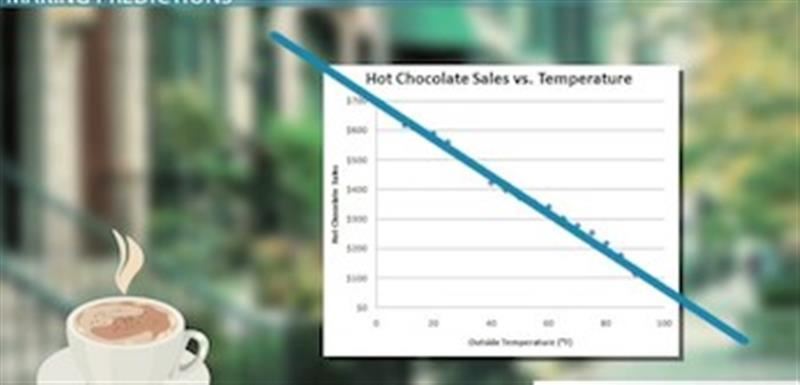Making Estimates
Of course, any estimates I make will not be exact. As you see, the actual data can fluctuate slightly from the line in the middle. But, my estimate can give me an idea of what to expect. For example, looking at my graph and the line that I've drawn through the middle of the dots, I see that if the outside temperature is 30 degrees Fahrenheit, then I can estimate that my hot chocolate sales will be around $500.
I can look on the x-axis to find an outside temperature I am curious about and make an estimate about how much I can expect to make in sales at that temperature. You try. What can you expect to earn if the outside temperature is 60 degrees Fahrenheit? By locating 60 degrees Fahrenheit on the x-axis, you can see that the point where the line reaches 60 degrees Fahrenheit is roughly at $350, so you can expect to earn around that much.
Making Predictions
In addition to making estimates along the line in the middle of the data, I can also extend that line to predict what may happen at other temperatures. Remember, you can only make estimates and predictions for quantitative data that have a pattern to them. If you can't draw a line of some sort through the data, then you can't make estimates or predictions about it. I was able to draw a line through my hot chocolate sales data, so I can make estimates and predictions on it.
kkk

When there is a pattern to the data, you can make predictions outside of the data range.
To make predictions, I need to extend my line. Extending my line in both directions above, I can see that as the temperature gets warmer, my sales get lower. But, when the temperature gets even colder, my sales increase even more. I can predict that at 100 degrees Fahrenheit, it is possible that I could earn about $100. But, what about when the temperature is at 0 degrees Fahrenheit? What kind of sales can I predict? By looking at my extended line, it looks like I can expect to make about $700.